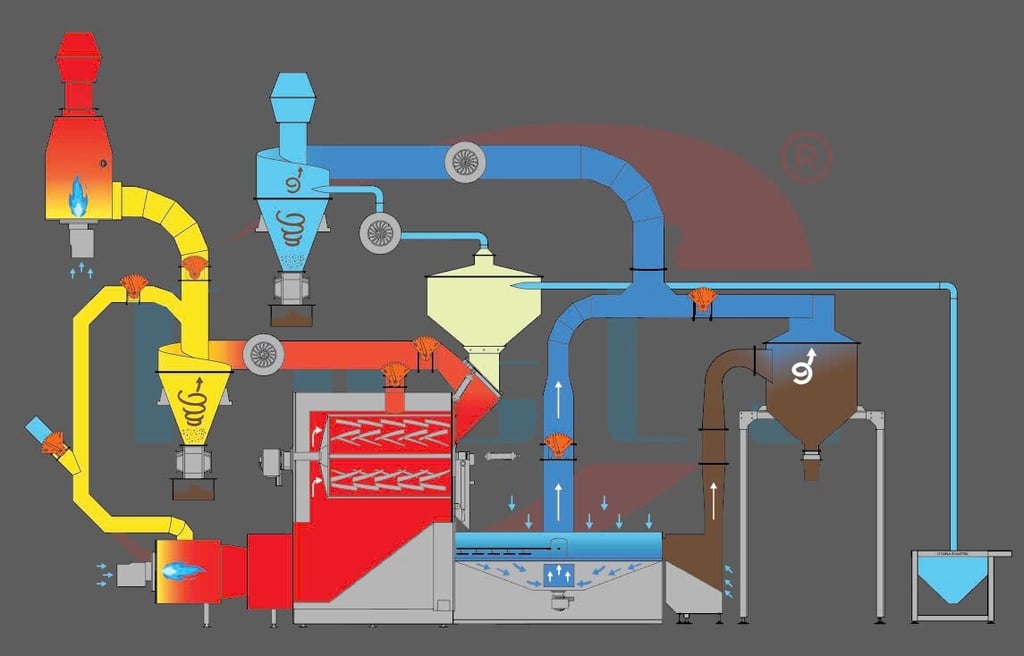Heat transfer methods in coffee roasting
During the coffee roasting process, heat is transferred in three main ways: - Conduction - Convection - Radiation Each method has a different effect on the flavor and development of the coffee bean. Below is a detailed analysis of each method and how they affect the roasting process.
3/5/20253 min read


1. Conduction
Definition: Conduction occurs when heat is transferred directly from one hot object to another through physical contact.
In coffee roasting:
Heat from the surface of the roasting drum is transferred directly to the coffee beans.
Important in drum roasters, especially with cast iron or thick drums.
Effects on coffee beans:
✅ Advantages:
Helps caramelize more strongly, increasing sweetness and body.
Creates even heat development if well controlled.
Necessary for roasting dark roasts or espresso blends.
❌ Disadvantages:
If there is too much conduction, it can easily burn the bean surface before the inside has time to develop.
Leads to a burnt or bitter taste if not well controlled.
How to control conduction in a roaster:
Adjust the drum rotation speed: The drum rotates faster → less conduction (because the beans have less contact with the hot surface).
Choose roasting drum material:
Cast iron retains heat well → more conduction → strong caramelization.
Thin steel conducts heat faster but is less stable.
Control drum temperature: Keep the drum at the right temperature to avoid thermal shock to coffee beans.
🔹 Suitable coffee types:
Brazil, Sumatra, Robusta (coffee with soft cell structure, low moisture → need more conduction).
Espresso blend, dark roast (need strong caramelization).
2. Convection
Definition: Convection occurs when heat is transferred through a moving gas or liquid, in the case of coffee roasting, a stream of hot air.
In coffee roasting:
Heat from the hot air stream is transferred to the beans.
Important in fluid bed roasters and drum roasters with strong airflow systems.
Effects on coffee beans:
✅ Advantages:
Helps the coffee beans cook evenly from the inside out, with less risk of surface burning.
Preserves natural acids, giving the coffee a bright and high clarity.
Important in light-medium roasts and specialty coffees.
❌ Disadvantages:
If the airflow is too strong, it can cause the beans to roast too quickly, causing them to not develop enough sweetness.
Too much convection can cause the beans to be "thin" and lack body.
How to control convection in the roaster:
Adjust airflow:
High airflow → Keeps coffee bright and clean (suitable for light roast).
Low airflow → Helps caramelize better (suitable for medium-dark roast).
Control UG valve (Under-airflow control):
Valve opens wide → more hot air → more convection.
Valve closes a bit → reduces convection, increases conduction.
Increase/decrease burner temperature to adjust hot air.
🔹 Suitable coffee types:
Ethiopia, Kenya, Colombia high-altitude (coffee has thick cell structure, needs convection to ripen evenly).
Light roast, single-origin, specialty coffee (needs to keep brightness, floral, fruity).
3. Radiation
Definition: Radiation occurs when heat is transferred from one hot object to another via electromagnetic waves (infrared) without direct contact.
In coffee roasting:
Heat from the drum wall, thermistor, or flame radiates and heats the coffee beans.
Important in charcoal roasters, infrared cookers, or roasting drums with glowing walls.
Effects on coffee beans:
✅ Advantages:
Creates caramelization on the bean surface faster.
Helps the body to be fuller, suitable for espresso and blends with high sweetness.
Creates some characteristic flavors such as light smoke, deep caramel.
❌ Disadvantages:
If the radiation is too strong → the surface burns before the inside is cooked.
Less control over uniformity compared to conduction and convection.
How to control radiation in roasters:
Choose the right drum material:
Cast iron absorbs and radiates heat better than steel.
Thin steel does not retain heat for long, so it radiates less.
Adjust the burner temperature:
Temperature is too high → Too much radiation → Surface burning of beans.
Lower temperature + increase airflow → Helps control better.
🔹 Suitable coffee type:
Coffee needs deep sweetness, strong caramelization (Brazil, Sumatra, espresso blend).
Mid-dark or dark roast.
4. Summary: When to use each method?
Conduction: When strong caramelization and thick body are needed, suitable coffee types (Brazil, Sumatra, Robusta, espresso blend)
Convection: When you need brightness, fruity aroma, light acidity, suitable coffee type (Ethiopia, Kenya, Colombia, light roast)
Radiation: When you need to create fast caramelization, strong aftertaste, suitable coffee type (Dark roast, charcoal oven, infrared machine)
5. Application in OTL roaster
OTL Roaster does not only use one method, but combines all 3 (conduction + convection + radiation).
Customize airflow, drum speed, burner temperature to control each roasting stage.
Helps roast diversely from light roast to dark roast, suitable for many types of coffee.
👉 Summary:
Conduction is important to create sweetness and body.
Convection helps keep acid and bright flavor.
Radiation supports fast caramelization and keeps a strong aftertaste.
The best roaster is the one that can optimize the balance between these 3 methods! 🚀
